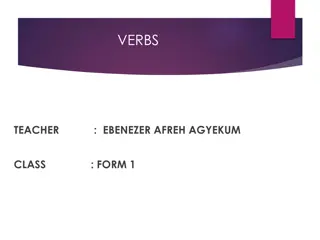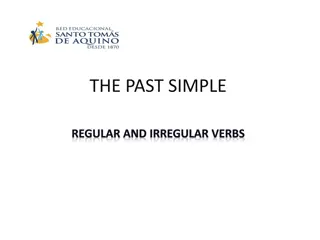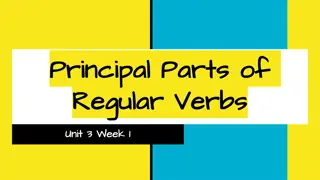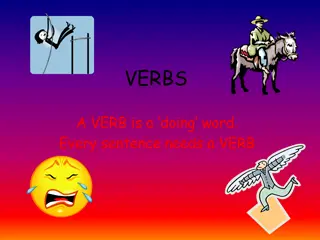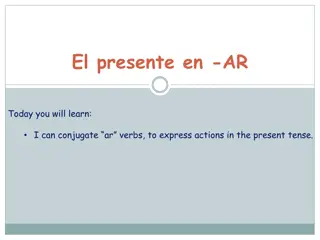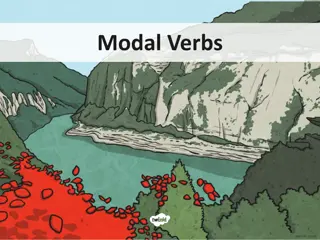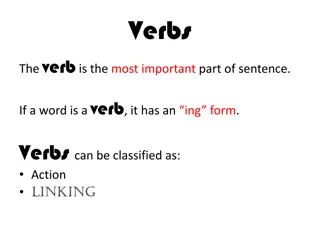Mastering the Past Participle in English Verbs
Understand how to form and use the past participle in English verbs, both regular and irregular. Learn the rules for forming regular past participles, including when to double consonants and when to change 'y' to 'i'. Discover examples of irregular verbs and how their past participles are formed. Explore using the past participle in dish names to indicate cooking methods. Enhance your grammar skills with these practical insights.
Download Presentation

Please find below an Image/Link to download the presentation.
The content on the website is provided AS IS for your information and personal use only. It may not be sold, licensed, or shared on other websites without obtaining consent from the author.If you encounter any issues during the download, it is possible that the publisher has removed the file from their server.
You are allowed to download the files provided on this website for personal or commercial use, subject to the condition that they are used lawfully. All files are the property of their respective owners.
The content on the website is provided AS IS for your information and personal use only. It may not be sold, licensed, or shared on other websites without obtaining consent from the author.
E N D
Presentation Transcript
THE PAST PARTCIPLE HOW TO FORM IT SLIDES 3 6 HOW TO USE IT SLIDES 7 8
Forming the Past Participle (Regular Verbs) Forming the Past Participle (Regular Verbs) If it's a regular verb, the past participle is the same as the simple past tense. In other words, it is formed like this: Add "ed" to most verbs: to melt > melted to roast > roasted to cook > cooked to boil > boiled to steam > streamed to struff > stuffed to melt > melted to poach > poached to mash > mashed to season > seasoned
Forming the Past Participle (Regular Verbs) Forming the Past Participle (Regular Verbs) If a verb of one syllable ends [consonant-vowel-consonant], double the final consonant and add "ed": chop > chopped, whip > whipped If the final consonant is "w," "x," or "y," don't double it: stew > stewed mix > mixed
Forming the Past Participle (Regular Verbs) Forming the Past Participle (Regular Verbs) If the verb ends in "e," just add "d": braise > braised slice > sliced smoke > smoked If the verb ends [consonant + "y"], change the "y" to an "i" and add "ed" fry > fried
Forming the Past Participle ( Forming the Past Participle (Irr Irregular egular Verbs) Verbs) If it's an irregular verb, the past participle is formed in all sorts of different ways. Here are some examples: freeze > frozen cut > cut break > broken beat > beaten grind > ground You just have to learn them. Luckily, cooking verbs are rarely irregular. Read more about irregular verbs (includes a list of the most common irregular verbs).
HOW TO USE THE PAST PARTICIPLE IN DISH NAMES HOW TO USE THE PAST PARTICIPLE IN DISH NAMES THE NAME OF THE DISH MAY INDICATE THE METHOD OF COOKING OF THE BASIC INGREDIENT OF THE DISH, FOR EXAMPLE: Barena argarepa Boiled carrot Pr ena riba Fried fish Pe eni krompir Baked potatoes Dim ena govedina Smoked beef Pohovani ka kava Breaded cheese Po irana pastrmka Poached trout
HOW TO USE THE PAST PARTICIPLE IN DISH HOW TO USE THE PAST PARTICIPLE IN DISH NAMES NAMES In the Serbian name of a dish gla golski pridev trpni denoting the method of cooking is sometimes placed after the name of the food: Gove i jezik dinstan Jag e i kotlet pohovan In the dish name in English, the position of the Past Participle is determined by the following rules: A single Past Participle usually stands before the noun: Braised ox tongue Breaded lamb cutlet Sauteed potatoes When Past Participle is part of a phrase, it stands after the noun: Cod braised in cream Salmon cooked in champagne




